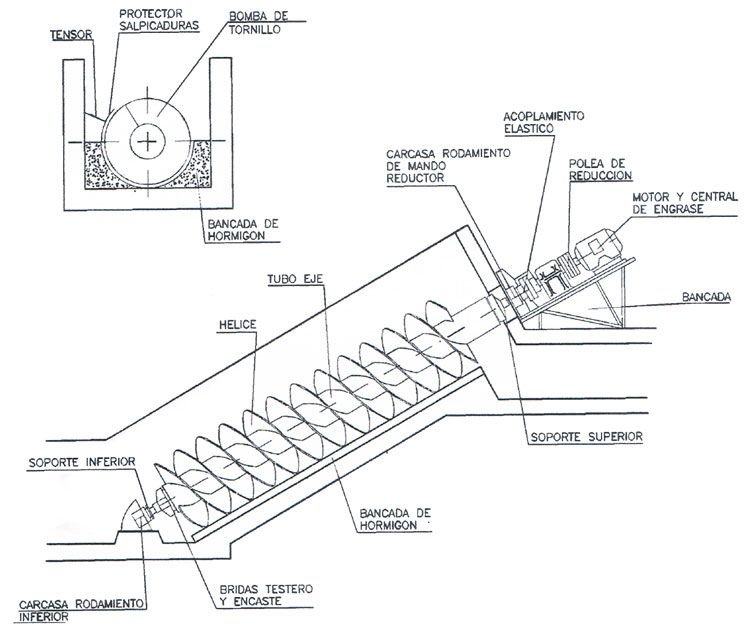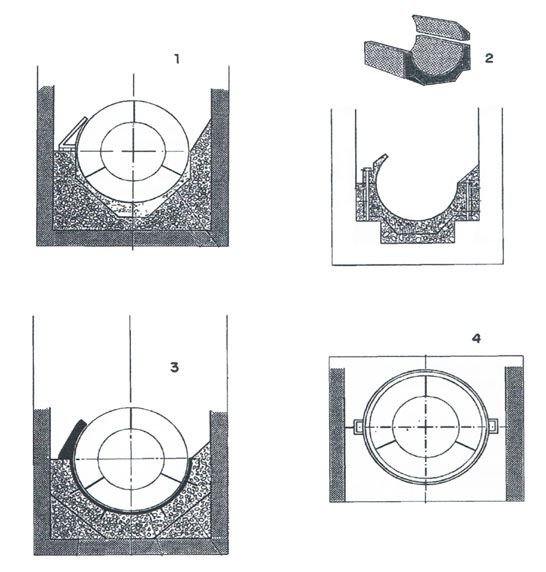Hello to all friends, after a long period without publishing product of my holidays, today I want to start a new series, which will deal with the important discoveries, of those crazy characters that day by day were making history on our planet, I say crazy characters because their imagination was very broad and could see beyond the common, today we will talk about this presentation of Arquimedes and its screw, if even this character was missing a screw in his head design his own screw, which had The main function of finding water, for the time, is currently a tool widely used in engineering. Below I invite you to observe this post.
An Archimedes screw is a helical gravimetric machine used to lift water, flour, cereals or excavated material. It was invented in the third century a. C. by Archimedes, from which it gets its name, although there are hypotheses that it was already used in Ancient Egypt. It is based on a screw that is rotated inside a hollow cylinder, located on an inclined plane, and that allows to elevate the body or fluid located below the axis of rotation. From its invention until now it has been used for pumping. It is also called an endless screw because of its infinite circuit.

Pinture creditswikimedia
Design
The Archimedes screw consists of a screw ("helical surface that surrounds a cylinder") inside a tube. The movement of this device is achieved thanks to a mill or manual work. Because the screw rotates, it causes the liquid underneath to ascend through the helical surface that surrounds it. It was used mainly for irrigation systems and to draw water from mines or other inaccessible sites.
If there is water that falls from one section, it will fall on top of the next one that will probably cause it to rise again. However, this fact would reduce the efficiency of the screw.
In some designs, the tube that surrounds the screw also rotates at the same time as this one instead of remaining fixed. The screw could be sealed with resin or some other adhesive on the outside. It can also be cast on a piece of bronze. Some researchers claim that this system is the one used for watering the gardens of Babylon, one of the seven wonders of the ancient world. We have a description of those used by the Greeks and Romans, who used human strength to set them in motion in the shell, so that everything was a piece.
The screw pump of Arquímedes HIDROMETALICA is built as a whole by the following elements:
- Flexible coupling
- Drive
- Shaft and propeller
- Bottom bracket
- Top support

pinture credits
Advantages and applications: Archimedes screw (TARQ)
The Arquimedes Screw Pumps HIDROMETALICA are the ideal option for handling flow rates up to 5500 l / s and lifting heights of up to 10cm. With these characteristics, the screw pump is ideal compared to other pumps for the following reasons:
Its length and its helix make it possible to handle muddy solid matter without the danger of plugging.
Optimal efficiency when leveling partial loads, guaranteeing considerable economy.
Slow speeds between 10 and 100 r.p.m., prevent premature deterioration, ensuring the durability of the coupling with a minimum maintenance cost.
The possibility of self-regulation of the screw pump varies depending on the water capacity, reaching constant speeds for each volume without additional control mechanisms.
-The pump housing channel does not need to be too deep. Neither of a special design to achieve an adequate suction.
- The material in friction even during a long period, does not damage the helicoid of the pump.
The Screw Pumps of Archimedes HIDROMETALICA are built in troughs of different designs:
1 . Artesa open concreted in situ.
2 . Artesa prefabricated by pieces.
3 . Artesa in steel sheet anchored to concrete.
4 . Compact crafts.

Pinture credits
Technical characteristics: Archimedes screw (TARQ)
The essential characteristics for the design of a Screw Pump are:
Fill point, maximum water level in the screw pump working at full capacity, but also with the highest energy consumption. It is located at the point of intersection between the upper generatrix of the axis and the extreme plane of the helix.
Point of contact, minimum level of water intake in which the impulse ceases.
Discharge point, water arrival level. It represents the maximum level at which the screw pump can drive without return.
Discharge point, located in the upper part of the trough of the screw pump and coinciding with the maximum level of the discharge channel.
Angle of the installation, normally between 30 and 40º.
Geometric height, difference in height between the point of contact and the pour point.Elevation height, difference in height between the filling point and the discharge point.
Applications
In addition to its use in irrigation systems, it was used for land reclamation in the Netherlands among others. The land of the sea is obtained and the water that it brings is pumped out of the closed area, beginning the process of draining the land for its use in agriculture.
The Archimedes screw was also used by John Burland, floor engineer, in 2001 to stabilize the tower of Pisa. Small amounts of subsoil saturated with water were removed below the northern part of the tower. In this way his inclination was corrected.
It is used in wastewater treatment plants, since they must deal with different flow rates and with suspended solids. They make use of it devices such as snow blowers or grain elevators. We find the same principle applied in fish farms, where they use them to lift the fish safely and transport them to another site. In this way the physical handling of the fish is avoided.
Not only serves to transport water, but also bodies, as we see in the image (above), in which a marble is transported. It is used especially to transport grains in silos systems.
Bibliography :
Kantert, P. J .: Manual para la bomba de tornillo Archimedean, Hirthammer Verlag 2008.
Kantert, P. J .: Praxishandbuch Schneckenpumpe, Hirthammer Verlag 2008.
Oleson, John Peter (1984), dispositivos mecánicos griegos y romanos para levantar agua. La historia de una tecnología, Dordrecht: D. * Reidel.
Oleson, John Peter (2000), "Water-Lifting", en Wikander, Örjan, Handbook of Ancient Water Technology, Technology and Change in History, 2, Leiden, pp. 217-302.
White, Jr., Lynn (1962), Medieval Technology and Social Change, Oxford: Clarendon Press.